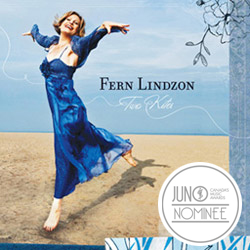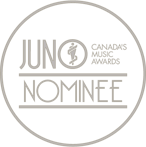 by Peter Hum, Ottawa Citizen jazzblog
by Peter Hum, Ottawa Citizen jazzblog
Toronto pianist/singer Fern Lindzon has expansive tastes, embracing everything from jazz standards to Brazilian material to her own arrangements of Yiddish and klezmer music. She makes her first appearance at Café Paradiso (199 Bank St.) on tonight and Saturday (May 6 and 7), joined by John Geggie on bass and Nick Fraser on drums. They will perform material from Lindzon’s new disc, Two Kites.
Below, Lindzon elaborates on her musical journey to date.
1. How were you bitten by the jazz bug?
Jazz kind of snuck up on me. When I was in high school I had a music teacher who invited me to an evening of free improvisation. It was a fascinating event where I was introduced to found and man-made instruments, a prepared piano and group improvisation. It had a huge effect on me, something that I didn’t realize until years later. After high school I studied musicology at the University of Toronto with a particular interest in ethno and 20th century classical music. During my third year there, I happened to be walking through Yorkville with a friend and we ended up stumbling into the Ship of Fools, a jazz club where the old Riverboat used to be. Among the musicians playing that night were Lorne Lofsky and Ted Moses. I was completely dumbstruck by what I heard and I knew that this was the direction I wanted my own music to take (that is, as soon as I finished my history degree!!!!). So this interesting combination of modern classical, free improvisation, ethno, bebop and post-bop became the basis of my growth as a jazz musician. I’m always reaching forward, backwards and sideways.
[Here’s one example of Lindzon and her group tackling a sort of musical melange — Loro, by the Brazilian genius Egberto Gismonti… ]
2. I see that your studies have included lessons with Don Thompson, Fred Hersch and Barry Harris, among others. What did you take away from each of these great musicians and teachers?
My first jazz teacher was Frank Falco. Frank was great at the basics, and to help pay for my lessons I’d copy Bill Evans charts for him. (I kept copies!) Through Frank I learned about voicings, transcribing solos, comping and playing a lot of tunes.
My next major teacher was Don Thompson. Don was totally intuitive and studying with him was profound and transformative. Every two weeks I’d show up at Don’s house for my two-hour lesson and most of the time my lessons went an hour or two overtime. I still have all the tapes! Don stripped away everything that was not real about my playing. At my first lesson he said, “from this point on you will never play another note that doesn’t mean something.” (I thought I was sounding pretty good at the time!!) That comment deeply affected me, and still does to this day. Much of the time Don and I just played duets!
I adore Barry Harris and have attended several of his master classes. I was introduced to Barry at a time when I was feeling that I needed a different kind of structure to my playing as well as a deeper understanding of bebop and harmony. Although I honestly feel overwhelmed by a lot of Barry’s ideas, one of the central things I learned from him was the concept of playing through changes and connecting everything harmonically. Chords are not isolated events. There is a beautiful fluidity to Barry’s playing and his ability to codify and explain bebop is quite amazing.
I first met Fred Hersch at the point when he was winding up his teaching because of health issues, so unfortunately I didn’t get to spend much time with him. However, a few years ago I audited a week-long master class he was giving along with Ralph Alessi, Jane Ira Bloom, Jason Moran and Kenny Barron at the Weil Institute at Carnegie Hall. That turned out to be an incredible experience. Fred has an exercise that I try to do as often as I can: take a tune, set a timer for 20 minutes and play a solo in which you deliberately give yourself one thing to focus on — a technical and/or musical problem. You play through your repertoire of “tricks” pretty quickly, and in order to stay interested and focused, this kind of exercise really forces you to become the musician you truly are and find your own sound. I’ve probably learned more about myself as an artist through this exercise than just about anything else I’ve ever done.
3. Which came first — piano or voice — and what’s been involved in integrating the two into your music?
I think I have always sung. My teachers used to comment that if I could sing through my classes I’d get straight A’s. When I was eight my mother started taking piano lessons. She practiced after putting me to bed, and I would look forward to getting into bed just so I could hear the piano. When I was nine I finally was able to take lessons, and I studied classical piano as well as voice right through university. Integrating piano and voice has been a long process. I’m now at the point where they can truly work together either as one unit or as isolated lines of counterpoint. I’m feeling much freer in my accompaniment, and I really enjoy surprising myself. It feels like a very natural and organic thing to be doing, though it certainly has been a long road.
4. Tell me what motivates you to incorporate Yiddish and klezmer music into your work.
Several years ago I attended KlezKanada for the first time. KlezKanada is a week-long, summer music camp in the Laurentians. I went there essentially to learn about klezmer music for another project I was working on. However, at the first faculty concert, I heard a duet by Christian Dawid on clarinet and Alan Bern on accordion that completely took my breath away! In that improvised duet of klezmer-based music I heard a sound that I knew I could translate into an improvised jazz form. It felt so modern and so old at the same time, and for me personally, it struck an ancient nerve as a kind of music that was buried very deeply in my ancestral past.
Over the last couple of years I’ve been exploring more and more of that music, and as I go back further, I’m discovering that I can bring in more contemporary approaches to it. Lately, I’ve been finding that there are ways to treat some of these beautiful old melodies with arrangements inspired by Kenny Wheeler and Maria Schneider, for example.
5. What’s one CD or piece of music that’s really knocking you out these days, and why?
Here are a few:
1. Kenny Wheeler’s album Gnu High. I’ve been listening to this off and on for a couple of years and everything about this record knocks me out. The writing, the harmonic concept, Kenny’s sound, Keith’s sound (!). It’s absolutely spectacular.
2. Maria Schneider’s recording of her composition Hang Gliding is amazing in itself, but also thanks to you, I have now been listening to Norma Winstone’s version of it. I also love Norma, and she is a huge influence. I love her current trio with Glauco Venier and Klaus Gesing and was fortunate to hear them live in Vancouver a few years ago. I love their chamber music approach to jazz. Hang Gliding has a beautiful freedom, energy and sense of flight. It’s a gorgeous piece of work.
3. Mary Lou Williams. I’m listening to Mary Lou because I’m doing a concert of her work at the Barrie Jazz Festival this coming June 11. She was an awesome pianist, and I’m totally blown away by her left hand! Her time is fantastic. I’m currently listening to (and trying to play) Roll ‘Em from Live at the Cookery. It is a tour de force of boogie woogie at its finest. It’s going to do wonders for my playing, I’m sure!
 by Maureen Murray, The Purple Cabbage, May 15, 2011
by Maureen Murray, The Purple Cabbage, May 15, 2011
